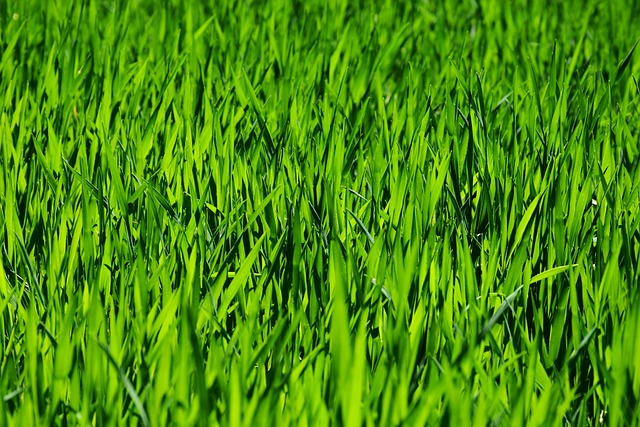Lawn care and landscaping are essential practices for maintaining a healthy and visually appealing turf environment. To achieve this, it's crucial to select the right grass variety that thrives in your local climate and soil conditions. Maintaining lawn health involves understanding and meeting the specific needs of your grass, including adjusting soil pH, implementing precise watering schedules, and applying appropriate fertilization. Regular maintenance tasks like setting the correct mowing height, aerating, and dethatching are necessary for a strong lawn, while integrated pest management helps protect against damaging pests and diseases with careful treatment applications.
Landscaping design plays a significant role in enhancing turf health and outdoor aesthetics by incorporating efficient irrigation systems, strategic mulching, and a layout that promotes airflow and sunlight for optimal grass growth. The design should complement the overall outdoor space's aesthetic, with lawn care practices supporting the landscape's beauty and functionality. Homeowners looking to elevate their property with a lush green lawn should consider the interplay between lawn care and landscaping, ensuring both practices are applied consistently for maximum effect.
In addition to visual appeal, a well-designed landscape serves practical purposes, offering recreational areas and contributing to environmental sustainability. Landscaping involves thoughtfully selecting plants and arranging hardscapes to achieve balance and functionality. Utilizing native plants can add character to the landscape, foster biodiversity, and reduce maintenance efforts. Well-planned walkways and seating areas make the space user-friendly and visually coherent with its surroundings.
Efficient irrigation systems are a key component of sustainable landscape design, conserving water and optimizing resource use. Outdoor lighting can enhance safety and extend the enjoyment of the landscape. By integrating these elements with dedicated lawn care practices, homeowners can create an outdoor sanctuary that is both a respite and an extension of their living space, significantly boosting curb appeal while promoting the health and well-being of the property and its inhabitants. This holistic approach to landscaping and lawn care emphasizes the creation of environments that are as beautiful as they are sustainable.
Embark on a journey through the verdant realms of lawn care and landscaping, where every blade of grass and stone-laid path tells a story of design synergy. This article delves into the art and science of cultivating lush turf and harmonizing landscape elements for both visual splendor and practical functionality. From the foundations of lawn care to the intricacies of integrating aesthetics with usability, discover how to bring your outdoor vision to life with effective implementation strategies. Join us as we explore the nuances of creating an outdoor space that’s as inviting as it is impressive.
- Foundations of Lawn Care: Cultivating a Thriving Turf
- Integrating Functionality and Aesthetics: Key Elements of Landscaping Design
- Bringing the Plan to Life: Strategies for Effective Landscape Implementation
Foundations of Lawn Care: Cultivating a Thriving Turf

Lawn care and landscaping are intertwined disciplines that culminate in the creation and maintenance of a thriving turf. The foundations of lawn care begin with selecting the appropriate grass variety for your local climate and soil conditions, as this will set the stage for a robust and resilient lawn. Understanding the specific needs of the chosen grass type is crucial; it dictates the optimal soil pH levels, the frequency of watering, and the types of fertilizers to use. Regular mowing at the correct height, aerating the soil to improve root growth, and dethatching to remove organic debris are all practices that support a healthy lawn. Integrated pest management is another key element in lawn care, which involves monitoring for signs of lawn pests and diseases, and applying preventive or curative treatments when necessary.
In addition to these practices, landscaping design plays a significant role in ensuring the longevity and aesthetic appeal of your turf. Effective irrigation systems should be installed to deliver water efficiently, minimizing waste and promoting even growth. Mulching around plants and borders can help maintain soil moisture and reduce weed competition. The layout of the lawn, including the placement of garden beds, walkways, and outdoor structures, should facilitate airflow and sunlight penetration, which are vital for a healthy turf. Landscaping design also involves considering the overall harmony between the turf and the surrounding environment, ensuring that the lawn care regimen supports this vision. With careful planning and consistent execution of these practices, your lawn can become a lush, vibrant expanse that complements your landscaping design and enhances the beauty of your outdoor space.
Integrating Functionality and Aesthetics: Key Elements of Landscaping Design

When crafting a landscape that is both functional and visually pleasing, integrating lawn care and landscaping practices is paramount. A well-designed landscape not only enhances the beauty of a property but also serves practical purposes, such as providing recreational space and improving environmental sustainability. The key to successful landscaping design lies in the harmonious blend of form and function, where every element—from the selection of plants to the layout of hardscapes—is chosen with intention. For instance, incorporating native vegetation not only adds a unique sense of place but also supports local ecosystems and reduces maintenance requirements. Similarly, strategic placement of walkways and seating areas ensures that the landscape is both accessible and inviting for human use while maintaining an aesthetic that complements the surrounding environment.
In addition to the visual appeal and usability, efficient irrigation and sustainable water management systems are integral components of a well-designed landscape. These systems conserve water, minimize waste, and ensure that the lawn and plants receive the necessary hydration to thrive. Furthermore, the integration of outdoor lighting can enhance safety and security while extending the enjoyment of the landscape into the evening hours. By thoughtfully combining these elements with attentive lawn care practices, homeowners can achieve a harmonious outdoor space that is both a retreat and an extension of their living environment. Landscaping design that marries functionality and aesthetics not only elevates the curb appeal but also contributes to the overall well-being of the property and its occupants.
Bringing the Plan to Life: Strategies for Effective Landscape Implementation

Engaging in lawn care and landscaping goes beyond mere aesthetic considerations; it involves a strategic approach to transforming a conceptual design into a thriving landscape. To bring this vision to life, meticulous planning is paramount. Homeowners and landscape professionals alike must consider the soil conditions, climate, and desired plant species before any groundwork is laid. A well-designed plan should account for the sun’s path, wind patterns, and the natural lay of the land to ensure that every element from shrubbery to flower beds complements one another.
Effective implementation hinges on a step-by-step approach. Once the design is finalized, the execution phase begins with site preparation. This may involve grading, soil amendments, and irrigation system installation, all of which are crucial for supporting healthy plant growth. Next, selecting the right turfgrass varieties and plants that are indigenous to the region can reduce maintenance demands and enhance resilience against local pests and climate challenges. After planting, a consistent lawn care routine, including fertilization, mowing, and weed control, becomes essential for maintaining the landscape’s integrity and beauty over time. Regular maintenance not only keeps the landscape in top condition but also promotes biodiversity and contributes to the overall health of the ecosystem.
In conclusion, a well-designed landscape not only elevates the visual appeal of any property but also fosters a healthy and sustainable environment. The foundations of lawn care, as outlined in our discussion, are crucial for cultivating a thriving turf that serves as a tranquil backdrop to the integrated elements of landscaping design. By blending functionality with aesthetics, homeowners can create an outdoor space that is both pleasing to the eye and beneficial for daily activities. Bringing these designs to life through strategic implementation ensures longevity and ease of maintenance. For those looking to enhance their property, mastering lawn care and understanding the principles of landscaping design are key steps toward achieving a harmonious and flourishing outdoor environment.
